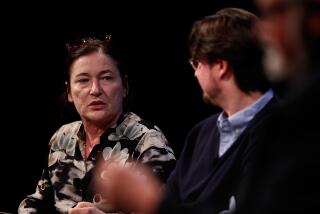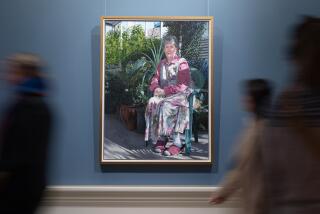Book review: ‘Anne Boleyn’ by G.W. Bernard
Anne Boleyn
Fatal Attractions
G.W. Bernard
Yale University Press: 238 pp., $30
This is a disturbing book for the reader of Tudor history, as it carefully analyzes and then demolishes many of the statements that we are accustomed to taking as facts about the life of Anne Boleyn. Indeed, any student of any history will feel the earth shake slightly as G.W. Bernard boldly states the open secret: that most of the written record is hopelessly biased, based on gossip and speculation, that witnesses lie and that historians seek their own version of events.
The slim history looks at the life and reputation of Anne Boleyn, reexamining what sort of woman she was, and how likely was that fatal accusation against her: adultery with five men, one of them her brother.
The question at the heart of this book is the very nature of Anne Boleyn, second and most controversial wife to Henry VIII. Even if you haven’t seen Natalie Dormer’s portrayal of her on Showtime’s “The Tudors,” you may still know what generally is said about her: that she was either the sexually manipulative, ambitious half-witch who destroyed Henry’s first marriage, made herself queen and was destroyed by the plots of her enemies; or that she was a heroine of the Reformation, a woman who led a wavering king into Protestantism, into independence from continental Europe and was martyred by the conservative forces she challenged — but whose daughter was England’s greatest queen.
Bernard rather diminishes the heroic status of Anne in his reading of her early life. Far from the reformist evangelical heroine of the Protestant myth, he suggests that she was not a major player in bringing any form of Lutheranism to England, and points to a sermon from her almoner who made a plea for the preservation of church ritual. He suggests she was no theologian and did not lead the assault on the papacy but was more the passive beneficiary when Henry took the power of the pope and declared himself free of his first wife, Catherine of Aragon.
This much will trouble those who like to see Anne as a heroine. But Bernard will make no friends either among those who see her as a manipulating temptress. He suggests that it was Henry who forced a regime of chastity upon the courting couple, desperate that his desire for a divorce should be seen as unsullied by an adulterous affair, and that the king was determined that any child they had be born in wedlock, a true, unquestioned Tudor heir.
Anne would have consented to be his mistress, it was Henry’s plan that she should be his wife.
So far, Bernard, a professor at the University of Southampton in England, has caused a substantial flurry in the hen coop of Tudor studies. But worse is to come. He examines the evidence against Anne of flirtation in the queen’s rooms, looks at the dates of her alleged affairs, cites a contemporary poem that had not been examined as evidence before and suggests that she may well have committed adultery with two of the noblemen accused with her, and — most surprisingly — with the young musician Mark Smeaton. Consistent with his own skeptical approach to the documents that incriminate her, Bernard calls this “a hunch.”
The difficulty for anyone wanting to know how a queen of England went to the scaffold is that the trial records have not survived. Bernard makes a good point when he shows that the initial inquiry must have been fair enough in that three other men, also named as the queen’s lovers, were cleared. Her brother George, conducting his own defense, nearly talked himself free.
This is a thought-provoking book. Some of the evidence that tends to contradict his thesis Bernard skips, and some he rejects. The suggestion that there was a homosexual network around Anne Boleyn led by her brother, and punished collectively in these trials, he dismisses briskly. The suggestion that Henry was horrified by Anne’s miscarriage in January, and took this as proof of sexual misconduct, Bernard examines, only to reject.
Bernard insists that Anne be seen as a sexually active being, which is refreshing. Thus, he dismisses the traditional notion that such a woman simply “would not” have taken five lovers: He looks at the smoke (and there is quite a lot of smoke) and suggests that there probably was a fire.
So far, so imaginative. But then, perhaps the imagination goes a little far. If we accept, as Bernard suggests, that the dates given at the trial for Anne’s love affairs are only approximate (and this is a jump he has to make — for she and the accused men were only in the right place at the right time for six of the 20 specified assignations), then we are left with a busy schedule indeed. This seems to me more “Desperate Housewives” than “The Tudors.” If we factor in the miscarriages that he does not mention (see Alison Weir’s “The Six Wives of Henry VIII”), Anne’s guilt on these occasions seems even more unlikely.
That she was flirtatious must be true. She attracted and held the most powerful man in England for six demanding years; she must have been utterly alluring. She must also (surely) have been clever and self-disciplined — not a woman to fall into bed with a different man every month for the sheer hell of it.
Might she have taken a lover? Yes, as Bernard does, I think so too. The great anxiety for Henry VIII was to conceive a son; that would have been Anne’s great anxiety too. Apparently, the most damning piece of evidence to be admitted at the trials was that she and her brother discussed the king’s impotence.
My Anne Boleyn is a woman forced to consider how to get a son for an impotent, tyrannical husband. She might have taken a lover to father a child, but she would never have endangered a pregnancy with countless affairs.
Bernard’s Anne Boleyn is a fool for love. There are many, many other versions of this woman, and as Bernard has powerfully demonstrated, there is evidence to suit them all, but nothing to prove any. She remains for us — as she was for the Tudors — a whore for some, a saint for others, a virago, a victim, a complex woman.
Gregory is the author of many novels, including “The Other Boleyn Girl” and the forthcoming “The Red Queen.”
More to Read
The biggest entertainment stories
Get our big stories about Hollywood, film, television, music, arts, culture and more right in your inbox as soon as they publish.
You may occasionally receive promotional content from the Los Angeles Times.






